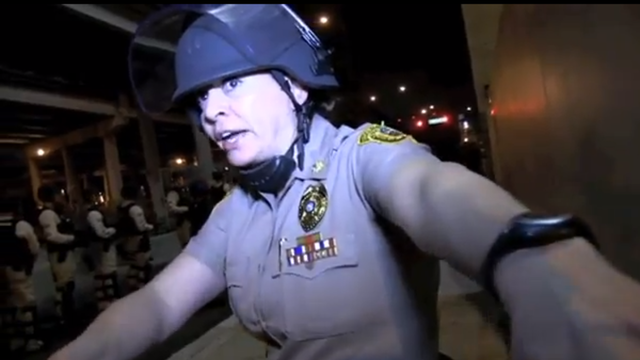http://www.wired.com/dangerroom/2012/09/seizure-fever-dazzler/
In 1998, a secret Army intelligence analysis suggested a new way to
take out enemies: blast them with electromagnetic energy until their
brains overload and they start to convulse. Amazingly, it was an idea
inspired by a Pokemon episode.
Application of "electromagnetic pulses" could force neurons to all
fire at once, causing a "disruption of voluntary muscle control,"
reads a description of a proposed seizure weapon, contained in a
declassified document from the Army's National Ground Intelligence
Center. "It is thought by using a method that would actually trigger
nerve synapses directly with an electrical field, essentially 100% of
individuals would be susceptible to seizure induction."
This wasn't the only method the Center suggested for taking down
combatants. Other exotic, less-lethal weapons included a handheld
laser gun for close-range "antiterrorist special operations roles"; a
"flood" of network traffic that could overload servers and "elicit a
panic in the civilian population"; and radio frequencies that could
manipulate someone's body temperature and "mimic a fever."
The military needed weapons like these because TV news had hamstrung
the military's traditional proclivities to kill its way to victory: It
now lived in a world where "You don't win unless CNN says you win,"
the report lamented. But while the Pentagon still laments the impact
of the 24/7 news cycle on the U.S. military, it hardly thinks
less-lethal weapons are a solution to it. In fact, the U.S. has kept
most of its electromagnetic arsenal off of the battlefield, in part
because the idea of invisible pain rays would sound so bad coming out
of an anchor's mouth.
Danger Room acquired this secret study on nonlethal technologies
thanks to a private citizen, who filed a Freedom of Information Act
request, and now wishes to remain anonymous. By coincidence, Sharon
Weinberger wrote a 2008 Danger Room report after independently
acquiring a piece of the document – an addendum that described using a
"Voice of God" weapon, powered by radio waves, to "implant" a
suggestion in someone else's mind. It wasn't even close to the
strangest suggestion made for exotic weaponry.
Perhaps the most disturbing item on the Army's nonlethal wish list: a
weapon that would disrupt the chemical pathways in the central nervous
system to induce a seizure. The idea appears to have come from an
episode of Pokemon.
The idea is that seizure would be induced by a specific electrical
stimulus triggered through the optic nerve. "The onset of synchony and
disruption of muscular control is said to be near instantaneous," the
1997 Army report reads. "Excitation is directly on the brain." And
"100% of the population" is supposed to be susceptible to the effects
— from distances of "up to hundreds of meters" — "[r]ecovery times are
expected to be consistent with, or more rapid than, that which is
observed in epileptic seizures."
That's not a lot of time — the Army's analysis noted that a grand-mal
seizure typically lasts between one and five minutes. But the analysis
speculated that the seizure weapons could be "tunable with regard to
type and degree of bodily influence" and affect "100% of the
population." Still, it had to concede, "No experimental evidence is
available for this concept."
The document cautioned that the effectiveness of incapacitating a
human nervous system with an electromagnetic pulse (EMP) "has not been
tested." But the analysis speculated that "50 to 100 kV/m free field
of very sharp pulses" would likely be "sufficient to trigger neurons
or make them more susceptible to firing." And a weapon that harnessed
an EMP-induced seizure could conceivably work from "hundreds of miles"
away. The idea might as well have been stamped "As Seen on TV."
"The photic-induced seizure phenomenon was borne out demonstrably on
December 16, 1997 on Japanese television when hundreds of viewers of a
popular cartoon were treated, inadvertently, to photic seizure
induction," the analysis noted. That cartoon was Pokemon, and the
incident received worldwide attention. About 700 viewers showed
symptoms of epilepsy — mostly vomiting — an occasional, if strange,
occurrence with TV shows and videogames due to rapid, flashing lights.
The Army's interest in the technology doesn't appear to have gone
anywhere. When Danger Room asked the Joint Non-Lethal Weapons
Directorate, the command overseeing the Pentagon's weapons that can't
kill you, if they had ever developed or explored developing an EMP
seizure ray, spokeswoman Kelley Hughes flatly replied, "No." But at a
minimum, it's bizarre that the U.S. military would entertain the idea
of neurological weaponry.
The seizure ray was just one of several futuristic nonlethal weapons
the National Ground Intelligence Center envisioned. Another favorite:
"handheld laser weapons" for blasting focused light against nearby
terrorists. These weren't supposed to be the sorts of lasers that can
burn through steel — after all, nearly 15 years after the Army intel
report, the Navy still doesn't have a laser cannon small enough to
mount on a ship. The "point and shoot" lasers were supposed to be
dazzlers, to disrupt sensors or even blind assailants from up to 50
meters away. Alas, the paper lamented, causing "permanent blindness"
was prohibited by binding international treaties, so development of
handheld dazzlers would likely be restricted. (As it would turn out,
"gross mismanagement" by U.S. military bureaucracy would be the larger
obstacle.)
Then came the cyberweapons. The Army intel report presciently
predicted using "information technology as a nonlethal weapon." It had
in mind "a campaign to disrupt a nation's infrastructure so that they
feel they are not ready for a formal conflict." No, the Army wasn't
thinking of any kind of proto-Stuxnet. It had in mind sending torrents
of traffic to "flood" foreign servers until "a panic in the civilian
population," now without internet access, "persuades the [adversary]
military not to execute a planned attack." Pay attention, Darpa and
U.S. Cyber Command. Alternatively, the military might disrupt an
enemy's ability to control its forces by flooding the internet with
tons of inaccurate information — "either through distribution of
disinformation or illegally altering web pages to spread
disinformation." It isn't clear if the report meant to restrict that
"illegal" activity to foreign web pages.
And then came the fever. The report speculated that blasts of radio
frequency waves could "mimic a fever" to the point of incapacitating
an enemy. ("No organs are damaged," it assured.) "Core temperatures of
approximately 41 degrees Celsius are considered to be adequate" — the
equivalent of a 105.8 degree fever, which is frighteningly close to
inducing a coma or brain damage.
The idea would involve a "highly sophisticated microwave assembly"
that could induce "carefully monitored uniform heating" in "15 to 30
minutes," depending on someone's weight and the wavelengths employed.
"The subjective sensations caused by this buildup of heat are far more
unpleasant than those accompanying fever," the report assured. Yet the
military would have to be careful not to cause any "permanent" organ
damage with such a weapon — which would take careful monitoring, as
the report noted that increasing someone's body temperature a single
degree Celsius beyond the envisioned 42 degrees would probably be
fatal.
As it turned out, the military would develop a microwave weapon — the
Active Denial System. That's a microwave gun that, as I learned
first-hand one fateful afternoon, makes victims feel like they've
stepped into a blast furnace. But its frequencies are too shallow to
penetrate the skin, and can't even pop a bag of popcorn. (It's been
tried.) Still, the idea of being heated with something like that for
15 minutes to a half hour is unbearable: I lasted maybe two seconds
before my reflexes forced me to jump out of the way of its beam. And
in 2010, the device was recalled from Afghanistan when commanders
realized it was a PR nightmare. It has one of the many downsides to
these weapons that the Army's 1998 that report didn't consider. Of
course, few things age worse than predictions for the future.
















